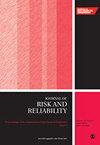无线通信网络的量子可靠性分析
IF 1.8
4区 工程技术
Q3 ENGINEERING, INDUSTRIAL
Proceedings of the Institution of Mechanical Engineers Part O-Journal of Risk and Reliability
Pub Date : 2023-06-30
DOI:10.1177/1748006x231182455
引用次数: 0
摘要
这项工作定位于量子概率论的新领域及其在无线通信网络可靠性分析中的应用。具体而言,我们介绍了用于计算5G无线电信网络可靠性的量子贝叶斯网络(QBN)的开发。与经典贝叶斯网络模型的定性比较可以突出干扰在计算复杂系统(如无线电信网络)可靠性中的作用。本文章由计算机程序翻译,如有差异,请以英文原文为准。
Quantum reliability analysis of a wireless telecommunication network
This work is positioned within the new field of quantum probability theory and its application to the reliability analysis of wireless telecommunication networks. Specifically, we present the development of a Quantum Bayesian Network (QBN) for calculating the reliability of a 5G wireless telecommunication network. The qualitative comparison with a classical Bayesian Network model allows highlighting the role of interferences in the calculation of the reliability of a complex system such as a wireless telecommunication network.
求助全文
通过发布文献求助,成功后即可免费获取论文全文。
去求助
来源期刊

Proceedings of the Institution of Mechanical Engineers Part O-Journal of Risk and Reliability
ENGINEERING, MULTIDISCIPLINARY-ENGINEERING, INDUSTRIAL
CiteScore
4.50
自引率
19.00%
发文量
81
审稿时长
6-12 weeks
期刊介绍:
The Journal of Risk and Reliability is for researchers and practitioners who are involved in the field of risk analysis and reliability engineering. The remit of the Journal covers concepts, theories, principles, approaches, methods and models for the proper understanding, assessment, characterisation and management of the risk and reliability of engineering systems. The journal welcomes papers which are based on mathematical and probabilistic analysis, simulation and/or optimisation, as well as works highlighting conceptual and managerial issues. Papers that provide perspectives on current practices and methods, and how to improve these, are also welcome
 求助内容:
求助内容: 应助结果提醒方式:
应助结果提醒方式:


